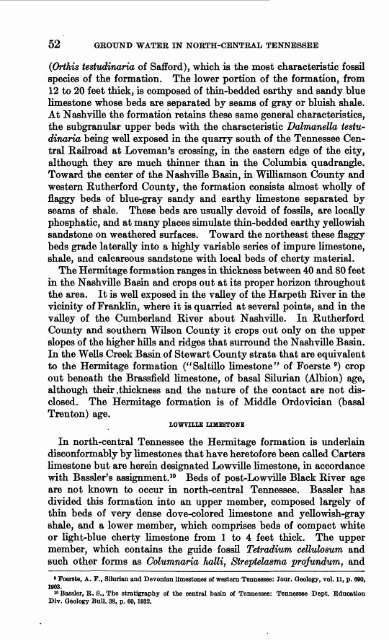GROUND WATER IN NORTH-CENTRAL TENNESSEE
GROUND WATER IN NORTH-CENTRAL TENNESSEE
GROUND WATER IN NORTH-CENTRAL TENNESSEE
Create successful ePaper yourself
Turn your PDF publications into a flip-book with our unique Google optimized e-Paper software.
52 GEOTJND WATBE <strong>IN</strong> NOETH-CBNTEAL <strong>TENNESSEE</strong><br />
(Orthis testudinarm of Safford), which is the most characteristic fossil<br />
species of the formation. The lower portion of the formation, from<br />
12 to 20 feet thick, is composed of thin-bedded earthy and sandy blue<br />
limestone whose beds are separated by seams of gray or bluish shale.<br />
At Nashville the formation retains these same general characteristics,<br />
the subgranular upper beds with the characteristic Dalmanetta testu-<br />
dinaria being well exposed in the quarry south of the Tennessee Cen<br />
tral Railroad at Loveman's crossing, in the eastern edge of the city,<br />
although they are much thinner than in the Columbia quadrangle.<br />
Toward the center of the Nashville Basin, in Williamson County and<br />
western Rutherford County, the formation consists almost wholly of<br />
flaggy beds of blue-gray sandy and earthy limestone separated by<br />
seams of shale. These beds are usually devoid of fossils, are locally<br />
phosphatic, and at many places simulate thin-bedded earthy yellowish<br />
sandstone on weathered surfaces. Toward the northeast these flaggy<br />
beds grade laterally into a highly variable series of impure limestone,<br />
shale, and calcareous sandstone with local beds of cherty material.<br />
The Hermitage formation ranges in thickness between 40 and 80 feet<br />
in the Nashville Basin and crops out at its proper horizon throughout<br />
the area. It is well exposed in the valley of the Harpeth River in the<br />
vicinity of Franklin, where it is quarried at several points, and in the<br />
valley of the Cumberland River about Nashville. In Rutherford<br />
County and southern Wilson County it crops out only on the upper<br />
slopes of the higher hills and ridges that surround the Nashville Basin.<br />
In the Wells Creek Basin of Stewart County strata that are equivalent<br />
to the Hermitage formation ("Saltillo limestone" of Foerste 9) crop<br />
out beneath the Brassfield limestone, of basal Silurian (Albion) age,<br />
although their .thickness and the nature of the contact are not dis<br />
closed. The Hermitage formation is of Middle Ordovician (basal<br />
Trenton) age.<br />
IOWVILLE LIMESTONE<br />
In north-central Tennessee the Hermitage formation is underlain<br />
disconformably by limestones that have heretofore been called Carters<br />
limestone but are herein designated Lowville limestone, in accordance<br />
with Bassler's assignment. 10 Beds of post-Lowville Black River age<br />
are not known to occur in north-central Tennessee. Bassler has<br />
divided this formation into an upper member, composed largely of<br />
thin beds of very dense dove-colored limestone and yellowish-gray<br />
shale, and a lower member, which comprises beds of compact white<br />
or light-blue cherty limestone from 1 to 4 feet thick. The upper<br />
member, which contains the guide fossil Tetradium cellulosum and<br />
such other forms as Columnaria halli, Streptelasma profundum, and<br />
Foerste, A. F., Silurian and Devonian limestones of western Tennessee: Jour. Geology, vol. 11, p. 690,<br />
1903.<br />
w Bassler, B. S., The stratigraphy of the central basin of Tennessee: Tennessee Dept. Education<br />
Div. Geology Bull. 38, p. 60,1932.

















